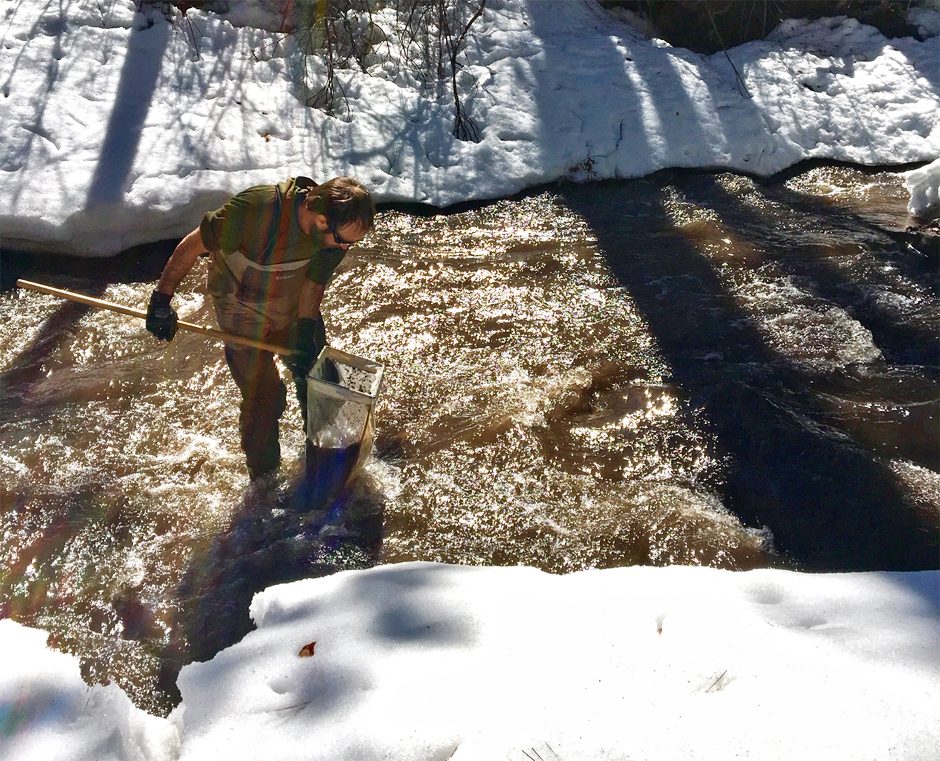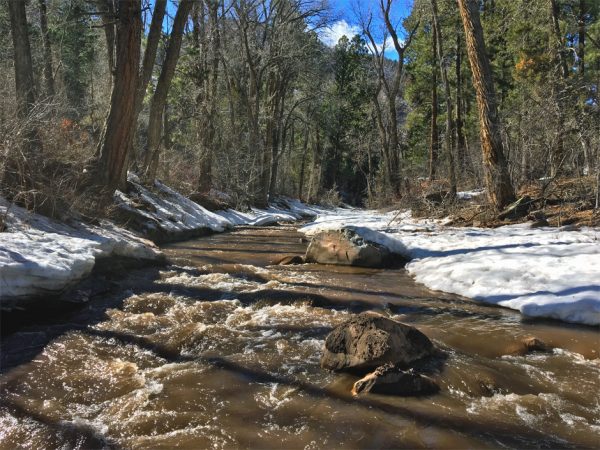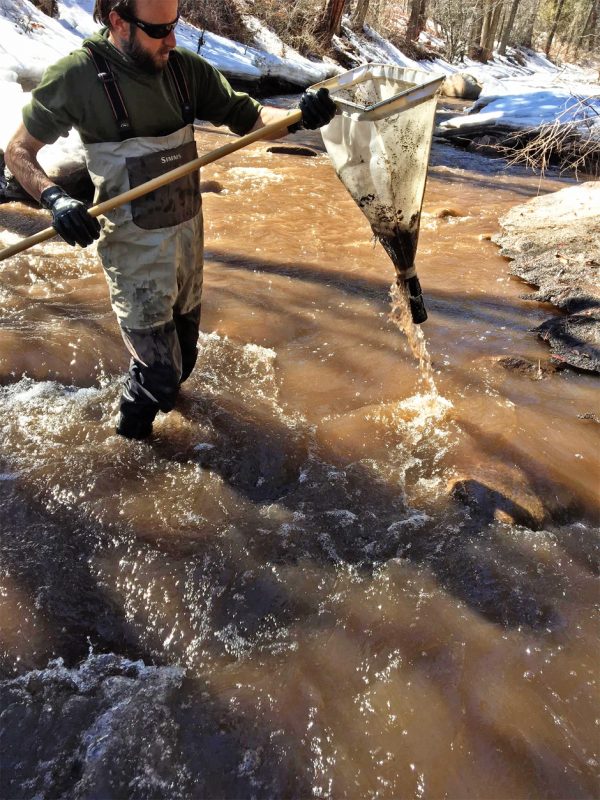The Mountain Studies Institute: Science on the Animas River
 Benthic sampling in Hermosa Creek, Colorado. (Credit: Scott Roberts, Mountain Studies Institute)
Benthic sampling in Hermosa Creek, Colorado. (Credit: Scott Roberts, Mountain Studies Institute)For around four years, aquatic ecologist Scott Roberts has been at the Mountain Studies Institute (MSI) in Colorado, most recently serving as Water Programs Director. Mr. Roberts recently took the time to speak to EM about the MSI and its programs, starting with community and educational outreach.
“We’re a not-for-profit, environmental education and research center based in the San Juan Mountains,” explains Mr. Roberts. “We do on the ground environmental research, mine hydrology, water quality monitoring, and forest health monitoring, and try to distill and distribute that information to address specific concerns that arise in the community. One thing that differs, I think, in our research program is largely driven by concerns in the community, rather than our own kind of academic pursuits. It’s usually shaped by efforts to try to address questions that come about in the community.”
Adding to MSI’s mission of outreach into the overall community is the team’s goal of following through. “When we do have an education mission, we try to bring results from our monitoring, news of the case studies, to help teachers in our local schools incorporate that into their curriculum,” comments Mr. Roberts.
Educational outreach works in two ways at MSI: outreach that is directly aimed at the public, and outreach to schools in particular.
“We try not to do research or science in a vacuum; we wanna share with the community and we do that in a number of ways, including through public presentations,” details Mr. Roberts. “We have public meetings where we give a presentation of information but also an opportunity for people to ask questions. Knowing that not everyone can come to a public meeting, we try to put a lot of information online, and it’s in formats that are easily digestible by community members. For example, we have a picture book style document on our website that walks people through interpreting water quality monitoring results for the Animas River here.”
The MSI team also conducts outreach in schools, appearing in classrooms with guest lessons or taking kids from local schools to the forest or the Animas River for hands-on lessons in aquatic insects, water quality, or how to measure forest health to give young people an opportunity to engage in science. This tactic allows researchers to include educational components in even their regular research—a smart way of doing more with existing work.
Environmental science shaped by geography and community
There are many facets to environmental science issues in the San Juan Mountains in Southwest Colorado where MSI is situated. The region spans forest, water, and climate category issues, but within them, there is a great deal of diversity, much of it driven by local geography.

Hermosa Creek, Colorado. (Credit: Scott Roberts, Mountain Studies Institute)
“I’m a geographer, by training, so I like it when people ask those kinds of questions,” remarks Mr. Roberts. “A lot of our questions arise in the community specifically because of geography. For example, the San Juan Mountains are a highly mineralized area. We had mining here and we’re still dealing with the impacts from legacy mining on water quality. The types of forests that we have influence beetle outbreaks and forest fires, some of which are naturally occurring on this landscape. Of course, there are questions in the community and concerns about how these issues affect them, downstream, or their forests.”
Any member of the community can get involved with MSI programs based on these kinds of concerns—or simply because they’re interested.
“We have citizen science programs trying to get people to go out and about hiking, making observations of species of concern and bringing that information back to a larger database to help track organisms,” Mr. Roberts describes. “Not just young people, we do try to engage adults in our classroom curriculum as well.”
Monitoring the Animas River
The MSI team has been engaged in water quality monitoring throughout its history, but water quality has been a bigger community concern since a 2015 release of mine water into the Animas River. The release, which made the international news with its bright orange water, was called the Gold King Mine release.
“Of course that captured international attention and raised a lot of concern in our community about water quality and the health of aquatic life,” comments Mr. Roberts. “In response to that community concern, we certainly expanded our water quality monitoring both spatially and temporally to try to address some of those questions.”
Then in 2018, the 416-fire burned a substantial portion of a major tributary to the Animas River.
“Having already established this water quality monitoring program, we were really poised to be able to conclusively assess the impacts from that fire, because we had this before data set,” remarks Mr. Roberts. “We knew what the condition of the river was before the fire, so now we track the impacts after the fire, and we could more conclusively say what the impacts were and also attribute those impacts directly to the fire. If we didn’t have that kind of before data, we wouldn’t be able to do that.”

Scott Roberts, Aquatic Ecologist and Water Programs Director, Mountain Studies Institute. (Credit: Scott Roberts, Mountain Studies Institute)
These kinds of results highlight the value of long-term monitoring—by both experts and laypeople—and the careful collection of data from an established field station.
“We’ve seen large amounts of sediment and black ash and organic material moving downstream,” Mr. Roberts describes. “We’ve seen high levels of nitrogen and phosphorous, really high levels of metal like aluminum, iron, and even mercury. We had a fish kill in July, after the fire as some of the first monsoon rains fell on the burn scar and carried water and sediment down into the Animas River. You didn’t have to be a biologist to observe it, just regular community members walking along the river could, unfortunately, see dead fish and fish gasping for their lives.”
The team is now working to investigate further, to determine what the water quality was like during the fire event, which caused the fish mortality, and how aquatic insect populations changed after the fire. Water quality remains a serious concern for the MSI team based on levels of metals, in particular.
“Because we had this longer-term data set on the Animas, over the past twenty years or so, we detected levels of aluminum, iron, mercury, manganese that were higher than any other time that we’d recorded in the past twenty years,” Mr. Roberts points out. “And that includes even when the river turned bright orange in the Gold King Mine release. That was a little unexpected, how high the levels of aluminum, iron, mercury, and manganese were.”
The team looks at water quality in two contexts: comparing historical observations deciphering the meaning of the metrics for aquatic life. In this case, after the 416-fire, levels of aluminum, iron, and mercury were high enough to suggest there could be a concern to aquatic life in the Animas River.
“There’s not really the same kind of water quality criteria for physical damage that can be done to fish from sediment and ash and organic material moving downstream, but there certainly is an impact,” Mr. Roberts states. “In fact, that may be most responsible for the fish kill, sediment clogging fish and insect gills, organic material damaging gills as the river gets choked with it.”
The presence of heavy metals could also be a component of local water quality problems. Finding out is what the team hopes to tease out now and in subsequent years of data collection, including what the longer term impacts on aquatic life are.




0 comments